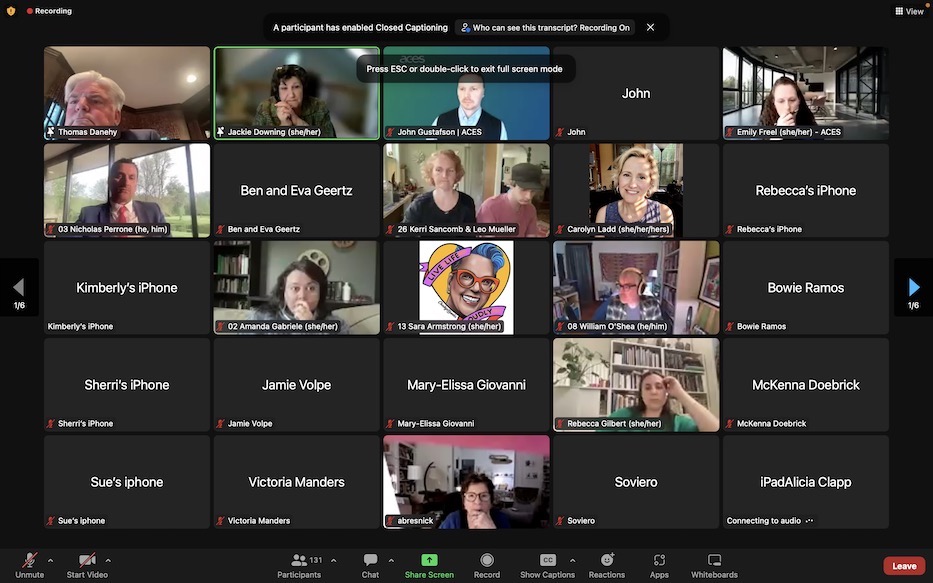
Culture & Community | Education & Youth | Educational Center for the Arts | Arts & Culture | Education

Aoife Spillane-Hinks is pictured in the top row, three boxes in. Screenshot via Zoom.
When Aoife Spillane-Hinks graduated from the Educational Center for the Arts (ECA) in 2002, she was ready for any directing project the world threw at her. At Harvard, she excelled in her classes, sailing through improv, Shakespeare and Brecht. When she went on to the University of Galway, it was her high school years that helped lay the foundation for graduate work.
Now, she leads a theater company in Ireland—and can’t imagine life without her start at ECA. So when she heard that her high school teacher’s job was on the line, she showed up to urge the administration to save it.
Tuesday night, Spillane-Hinks joined over 130 ECA parents, students, educators and alumni in a packed Zoom meeting, as representatives of Area Cooperative Educational Services (ACES) convened a community forum to discuss a number of proposed budget cuts at the Audubon Street arts magnet school. Those proposed cuts would reduce the hours of work of the school’s five department heads (see more on that below).
The meeting included a chance for attendees to give public testimony, which 31 people ultimately did.
In impassioned remarks, students, parents, grandparents and alumni all pointed to ECA’s unique conservatory approach as one worth saving at all costs. Those who did not speak often chimed in with applause emojis and “+1” shows of solidarity in the comments.
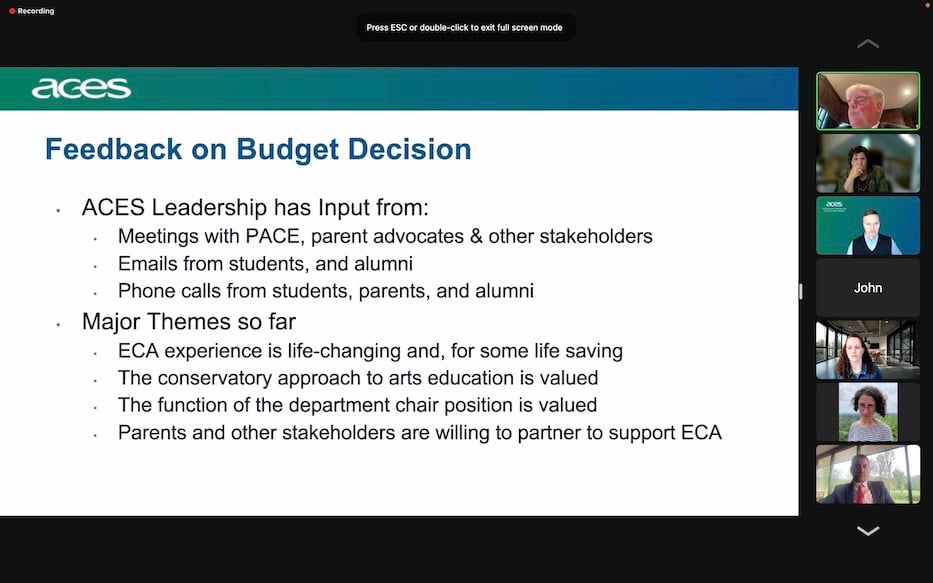
The North Haven-based ACES, which operates as a Regional Educational Service Center (RESC), is ECA’s parent agency. By the end of the meeting, ACES Executive Director Tom Danehy promised to revisit enrollment numbers, marketing and recruitment strategies, and the existing budget by June. “We’ll have more information out to you as information becomes available,” he said.
It marks the latest chapter in a three-week period of upheaval for the school, a small arts magnet that sits at the corner of Audubon and Orange Streets in New Haven. In a message to parents last month, Danehy announced that the agency would be cutting back ECA’s department chairs in Dance, Music, Creative Writing, Theater and Visual Arts, who are currently employed at .8 Full-Time Equivalent (FTE).
Under a new model, all five departments would fall under the leadership of a single new assistant principal at the school, and department heads would remain at the school as part-time (.5 FTE) teachers. The assistant principal has not yet been hired; incoming Principal Kevin Buno is expected to start for the 2023-2024 academic year.
The department chairs include Saul Fussiner in Creative Writing, Amy Christman in Music, Johanna (Hanni) Bresnick in Visual Arts, Mariane Banar-Fountain in Dance, and Ingrid Schaeffer in Theater. Currently, they develop and implement curricula, invite teaching artists, manage department budgets and provide one-on-one, specialized attention and advising to students.
Danehy, who began his tenure in June 2014, has repeatedly cited declining enrollment and a $500,000 deficit as the driving factor behind the cuts (he originally reported that enrollment was down to 266; it is currently at 283, according to ACES number shared Tuesday). He has also referenced an ongoing study from Odyssey Associates that the ECA community has not yet seen. Odyssey Principal Josh Borenstein declined the Arts Council’s request to see the study on the basis of confidentiality.
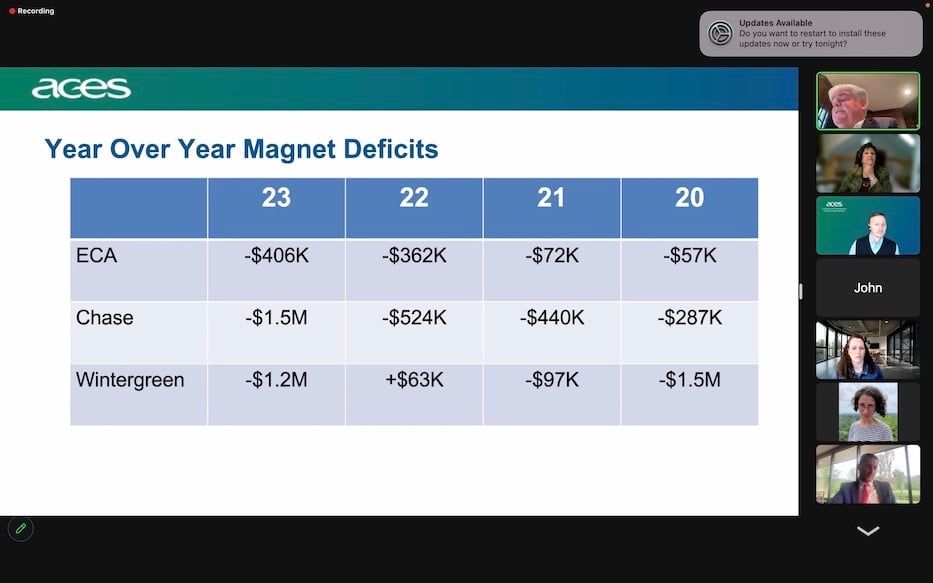
Danehy did not respond to multiple requests for ACES’ current fiscal year budget. The agency’s 2021-2022 annual report lists its overall budget at $113 million, and ECA’s operating budget as just under $3.5 million. At a meeting of ACES’ governing board Thursday morning in Hamden, Danehy also cited enrollment for the 2023-2024 school year as 299, based on families who have accepted a slot at the school.
Following a request from the Arts Paper, the Connecticut State Department of Education (CSDE) has reached out to its fiscal office to “to find out what we have available” for the current ACES budget year, according to department Director of Communications Eric Scoville.
Tuesday and again in an ACES Governing Board Meeting Thursday, attendees expressed both frustration at ACES as well as their deep love for the school, which many described as life-saving and life-giving. Speaking early in the evening, ECA parent Sarah Fader noted the change that she has seen in her own son, who is currently studying creative writing, since his arrival at the school.
Before he got to ECA, she said Tuesday, he had a history of avoidant behavior, and would often refuse to go to school. Then he met Fussiner. She’s watched him transform into a different student, who is more excited about his work and his classes. That wouldn't happen, she suggested, without the work of the department chairs. ”They are the heart and soul of ECA,” she said.
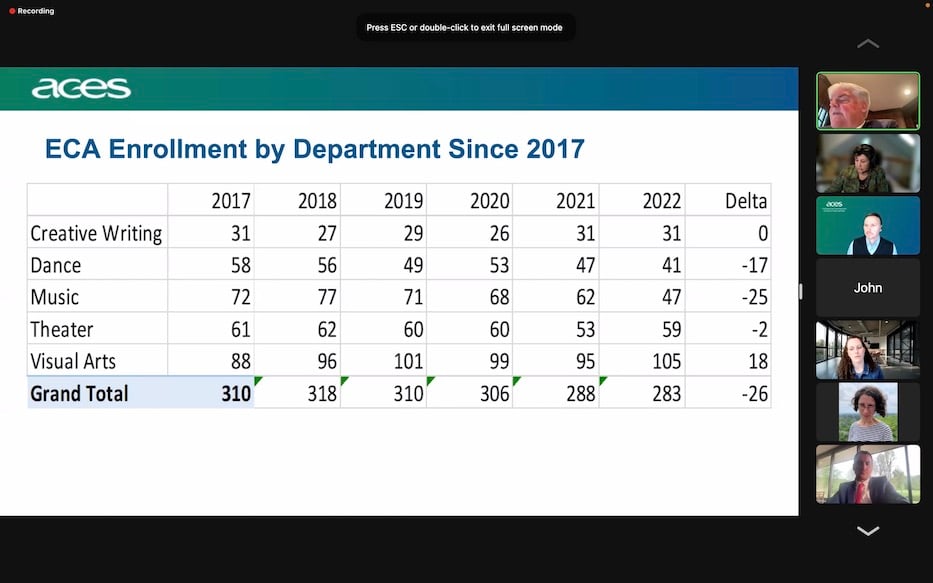
Ilisa Kellman, whose son Claude Saunders is studying theater and also testified on Tuesday, stressed the singularity of ECA’s model, a half-day program with students from 24 regional “sending” districts that lets them specialize in a single art form. During the first half of the day, Saunders attends Wilbur Cross High School, where the Lights Up Drama Club has become a kind of second home.
Then in the afternoon, he goes to ECA, where Schaeffer and fellow theater faculty push him to stretch his skills with college- and graduate-level curricula. He called the school as “unique” as he is, with almost 300 young artists who are excited to practice their craft in community with each other each day.
“This is a conservatory,” Kellman said, “My son has always liked to act, but this training has taken his skills to another level. The theater department is unsurpassed in its generosity and commitment … [without the chairs] ECA would cease to be a conservatory and it would just become a fee for service art school.”
She added that Danehy’s announcement that part-time faculty would also be receiving a pay cut was, and continues to be, “really insulting.” In an email to the Arts Paper on April 24, Danehy said that the budget “also has reductions of $89,150 for part-time instructors.” At a time when costs are rising, Kellman said, it deeply undervalues the work of teaching artists and educators.
Why, she pressed, had parents not been contacted about fundraising or marketing efforts? Danehy’s April message about the cuts was the first that many parents, if not all, had received any communication on the 2023-2024 budget from ACES. “The parent community, we’d be very much willing to put energy into ECA to keep it as it is,” she said.
“What Happens At ECA Is Mindblowing”
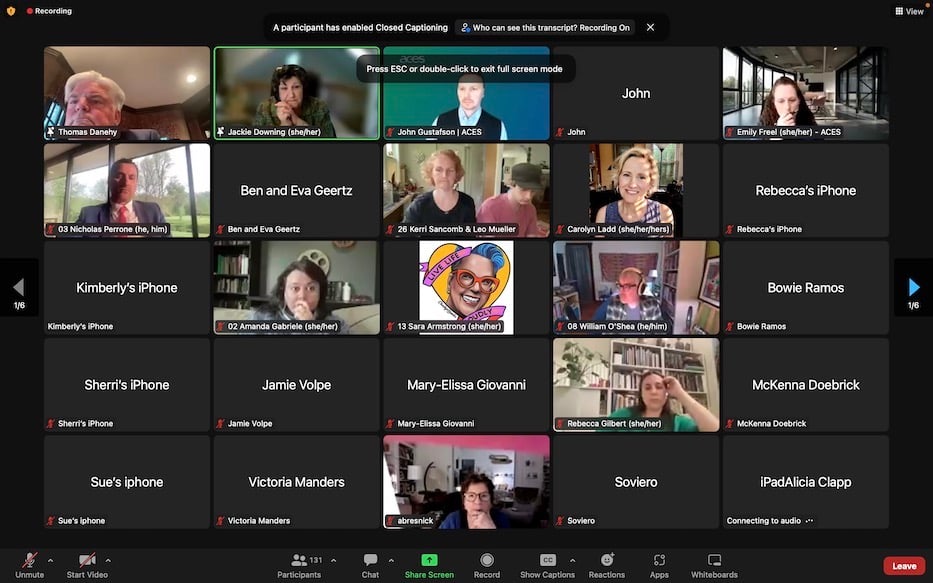
Students and alumni who hopped on the Zoom call, some from an ocean away, also emphasized the sheer impact of the school and its teachers on their lives. In page after page of one-inch Zoom squares, it was possible to spot whole families, with parents, grandparents, and children who often testified one after the other.
Senior Alyssa Rinaldi, who is studying the cello, applauded the close attention she has received in the music department, particularly from part-time teachers Roy Wiseman and Polina Nazaykinskaya. Tuesday, she said that ECA has been instrumental to “finding out who I am and understanding what I want to do in my future.”
She wants that for students who come through the school after her, she said. While she hasn’t had Christman as a teacher, she sees how much work she puts into the program, from inviting visiting artists to annual course offerings. She can see, she said, that her chair is there to provide academic counsel to students who need it.
Sculptor and multimedia artist Molly Gambardella, who studied with Bresnick from 2008 to 2012, ventured that she would not be an educator herself had it not been for ECA. During Gambardella’s time at the school, Bresnick was more than an instructor—she made Gambardella feel like a future as an artist was possible. Gambardella has come back to that more times than she can name.
In a 2019 studio interview with the Arts Paper, Gambardella remembered watching transfixed as Bresnick showed students how to use power tools, then asked her specifically to try them out. After graduating, Gambardella honed her craft—first out in the world, including in several justice-oriented spaces, and then with degrees at Paier College of Art in 2017 and the Vermont College of Fine Arts in 2021. Without ECA, she wouldn’t have gotten to her MFA graduation this past February, she said.
To eliminate the department chairs “would compromise the entire structure of the institution,” she said. “The future of this program needs a more thoughtful and inclusive approach.”

An image from the student walkout in late April. Lucy Gellman File Photo.
Spillane-Hinks, who is now the artistic director at the Then This Theatre Company in Ireland, echoed that message. She remembered getting her start at ECA two decades ago, when Schaeffer recognized her knack for directing. During Spillane-Hinks’ senior year, Schaeffer placed her in multiple assistant director roles, with complete faith that her student could soar. By the time she headed to Harvard, Schaeffer had planted and watered “the seeds of my life as a director.” They haven’t stopped blooming since.
“Ingrid changed my life and put me on this course that changed who I am today,” she said, noting that it was almost 1 a.m. in Ireland, and staying up had been well worth the wait. “Ingrid has been responsible for guiding me and my classmate through thoughtful strategic choices … she is building the foundation of young artists.”
Other attendees pointed to the shortsightedness in cutting the department chairs—perhaps the school’s greatest and most unique draw—as an answer to declining enrollment. Without department chairs, ECA could lose what makes it ECA. What may appear to save costs in the short term, many said, could ultimately devastate the school.
Edgewood Magnet School Principal Nick Perrone, an arts booster who is also an ECA parent, looked at the potential harm of making cuts this year in particular. In July, ECA is welcoming a new principal, Kevin Buno, as Principal Leslie Abbatiello steps down from the position. As an administrator himself, Perrone doesn’t see the approach as setting Buno up to succeed.
He noted the importance of the department chairs as vital “thought partners,” whose individual and collective knowledge can help Buno navigate a new institution.
“These people are key leaders of the team,” he said. If they are cut, it’s “likely to prevent the retention and recruitment of teaching artists and contribute to decreasing enrollment.”
A self-described “old-school punk rocker,” lifelong New Havener and New Haven Public Schools science teacher, fellow ECA parent Billy O’Shea added that ACES has cited declining enrollment, but has done next to no marketing of the school. Having watched his son excel in the music department, he knows how transformative the school can be. After a 2018 CSDE decision cutting dual magnet enrollment, his family was one of many that chose between New Haven Academy and ECA, and ultimately chose ECA.
“In my opinion, ECA is an extraordinary product,” he said. “What happens at ECA is mindblowing and I’ve been watching it and seeing it my entire life, envious that it wasn’t part of my experience … Do your job. Sell this school.”
For years, it appears that there haven’t been significant marketing efforts for the school. In an interview Thursday afternoon, former ACES Board Member Alicia Clapp remembered the “Liaison Luncheon,” an event during which sending districts learned about ECA at a lunch, and had a chance to see what the school was all about. “It was mind boggling to see the reaction on some of the [attendees’] faces,” she recalled. Those ended roughly a decade ago.
As the grandmother to two ECA alumni, she doesn’t need evidence that ECA’s model works—she sees it in her grandchildren every day.
What’s Up Overseas?
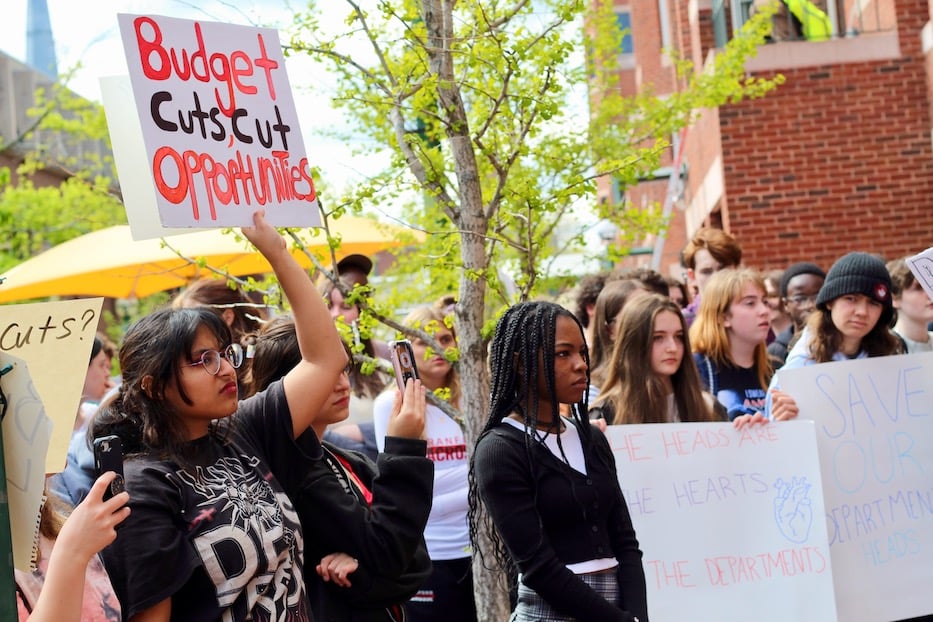
ECA students at a walkout in late April. Lucy Gellman File Photo.
Evan Gambardella, who studied theater at the school, noted a broader lack of oversight that he has observed at ACES for years. In 2018, he was hired by ACES International to teach a theater program in Beijing alongside ECA faculty members Peter Loffredo and Melissa Matthews. At the time, he said, two representatives of the program told them that there was a campus waiting, and that the three together would be teaching 250 students.
But when they arrived, the “campus” was not a campus at all. Instead, the three worked out of a rented room at the Beijing Film Academy, which was over two hours from the city center. The 250 students they had been promised turned out to be a group of five young people. During a journaling exercise, Gambardella recalled, one of the students wrote about wanting to buy a gun and kill her former classmates.
Gambardella, who was in his 20s, remembered feeling helpless. Every time he and Loffredo alerted ACES, “we just kept getting gaslit,” he said. ACES International did not respond to a request for comment.
“We trusted you to have done the research and looked into this program and instead we walked into a minefield,” he said Tuesday, speaking directly to Danehy. “You are asking me, and everyone in this Zoom room, to trust you again.”
“If the proposed budget cut must happen, have it come from ACES International,” he continued. “ACES Educational Center for the Arts has been here for 50 years. You haven’t shown up to performances, openings … You are playing with something that is so fragile and so special. And you are messing with something that has the potential to ruin so many people’s lives.”
Visual arts alum Ruby Gonzalez Hernandez, who graduated in 2016, also said that the proposed cuts strike her as completely out of touch. As a student at ECA, Gonzalez Hernandez received close mentorship from Bresnick, setting down a foundation that bloomed into exhibitions, collaborations, and both national and international recognition.
As recently as this year, Gonzalez Hernandez founded a community of practice called Fair-Side, meant specifically for artists living and working in New Haven’s Fair Haven neighborhood. “I am an example of why ECA works and needs more support and not less,” she said.
She questioned whether ACES leadership had any actual sense of what was going on at the school, noting the lack of student, parent, alumni, and teacher input before the announcement last month. The cuts don’t give the school a framework for posterity, she said—they set Buno up to fail. “This is not what students parents alumni staff and community members want,” she said.
“An Unacceptable Response”
Thursday, parents and alumni echoed that message at 205 Skiff St. in Hamden, as they gave testimony at a meeting of the ACES Governing Board. Among them, ECA alum and New Haven mayoral candidate Tom Goldenberg stressed the connection between arts education and the social and emotional skills that allows students to excel in and beyond the classroom.
He pointed to the sheer amount of work that department chairs do, from writing and implementing curriculum to inviting teaching artists, managing budgets and working closely with students. For him, the decision to cut back their positions as a cost-saving measure is one that doesn’t add up.
He proposed that instead of making budget cuts at ECA, ACES "reach into their pockets" for other sources of funding, in an agency that includes head start and special education, summer programs, marketing and transportation arms, and ACES International. In addition, and like many of Tuesday’s speakers, he called for more sustained marketing, recruitment, and retention efforts for the school.
“The return on investment on ECA as a magnet school has been realized many times over,” he said. “Given these artists’ contributions to society, not to mention hundreds of students, myself included, who have experienced ECA as a safe haven for individual and artistic exploration.”
“ACES can and must do more to ensure the high standards that ECA has set for decades,” he later added. “Cutting department head positions is an unacceptable response to the situation. ECA is an institutional asset to New Haven … and as a steward of that asset, ACES owes the community a better response to the situation with clear commitment.”
It is not the first time Goldenberg has spoken out: earlier this month, he sent a letter to the CSDE urging them to reconsider a 2018 decision that cut off funding for dual enrollment in magnet programs (in other words, an ECA student can not also attend New Haven Academy or High School in the Community).
In that same communication, he pointed to ECA alumni who have since become professional performing artists, including Christian Sands, Wayne Escoffery, and Craig Hartley.
ECA parents Laura Cross and Christina Shallow, who were also in attendance at the meeting, said that they were surprised to hear from an ACES board member that department chairs reduced to .5 FTE at ECA could be “made whole” by working an additional .3 FTE at a different school or program in the ACES network.
If that’s the case, Shallow asked in a Zoom call with the Arts Paper Friday, why not just maintain the .8 FTE positions at ECA, where the chairs are already stretching themselves? Both she and Cross noted that the chairs have a specialized knowledge that is specific to ECA: they have not designed curricula for other programs.
"We just want them to pause, take a closer look at everything, and keep it intact,” she said Friday.
“ACES is a large agency with plenty of moving parts, especially over a summer,” Danehy wrote when asked for clarification. “ACES employs nearly 1200 staff members at various schools, programs and locations throughout New Haven county. ACES is a fee for service, not for profit, regional education service center.”

